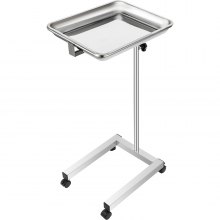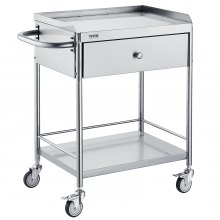













Choosing the right furniture is crucial in a laboratory setting to maximize efficiency, arrangement, and the workspace. We will look at the many kinds of lab furniture, how they are designed, and how they affect research results, worker safety, and workflow effectiveness.
VEVOR Lab Furniture strives to maximize productivity and safety in the lab environment, offering everything from ergonomic seating and specific storage solutions to cabinets and benches for laboratories. VEVOR Lab Furniture may assist you in creating a comfortable and productive workspace, improving the overall caliber of your studies and experiments.
Considering that it facilitates the staff's everyday tasks, laboratory furniture is essential to any properly operating laboratory. From this angle, it is also critical to remember that, in the end, we need to select the furniture in a manner that maximizes user productivity and workflow.
Quality is required since the furniture ought to last for as long as it takes to meet the requirements of the job and the business or organization. The condition of the lab equipment should always ensure that the efficiency of the job in the lab is maintained.
Excellent design encourages efficient workflow, whereas poor design obstructs the work's natural flow. This is why design affects productivity. The layout should support productivity and the capacity to complete tasks while enhancing the tidy surroundings.
No matter what kind of job your staff is doing, consider these things when choosing your lab furniture to ensure optimal productivity.
Lab work differs significantly from one lab to the next and even from one task to another. A university research facility, a corporation's processed food trial center, or a beauty company's smell-producing area could all be outfitted with lab furnishings. Every lab has a different purpose, goal, and use; varied furniture is needed to achieve those objectives.
Each lab manager can set up the lab to best suit the occupants' demands using variable lab furniture. The choice of lab furniture should include the flexibility to adjust workstations to meet the employee's demands and the project's specifications.
Any study or testing facility must have medical laboratory furniture because it offers the infrastructure for carrying out tests, keeping equipment organized, and guaranteeing worker safety. Several types of lab furniture are available to fulfill particular functions and particular needs in distinct laboratory environments.
· Workstation: Work tables are the most essential furniture in science labs. Most companies offer fully furnished workstations made of steel, complete with a balancing surface, sink, sections, bin, and other necessary items.
· Storage Cabinets: Due to the dangers of toxic chemicals and other hazardous materials, scientists have begun to use flammable storage cabinets, which do not burn down and protect other laboratory supplies.
· System for Extracting Fumes: A fume hood is another crucial piece of equipment in any science lab. They remove all harmful pollutants and gasses and provide an eco-friendly environment. Scientists in a well-ventilated laboratory can extract better results and solutions.
· Chairs and Stools: Standard chairs and stools differ from those used in laboratories. These are made to be comfortable for extended lab sessions. Some seats and chairs include wheels for movement or can be raised or lowered.
· Basin Units: The most important things to remember when maintaining any labware goods are cleanliness and hygiene. Sinks and taps are crucial for ensuring them. They come in several varieties, with built-in sinks for workstations and stations, individual tap stations for quick cleanup, and chemical bathrooms.
· Lab Carts: Utility carts, sometimes referred to as lab carts, are available in a variety of styles and forms to suit a range of laboratory requirements. The particular needs of the lab and the jobs it must do determine which lab cart is best.
Establishing a secure and effective laboratory setting requires careful installation of lab furniture. Here are some pointers for installing lab furniture:
· Plan and Design: Ensure you have a thorough plan and layout before beginning installation. Consider the lab's design, the kinds of tasks or experiments that will be carried out, and the safety regulations.
· Safety First: Ensure all safety precautions and instructions are followed during installation. This entails wearing personal protective equipment, adhering to chemical safety procedures, and ensuring available emergency supplies.
· Ventilation and Utility Connections: Make sure that any connections to gas, water, or electricity the lab furniture may need are made correctly. This is crucial for exhaust systems, sinks, and other gear that depends on these utilities.
· Cable Management: Ensure that wires and cables are neatly arranged and controlled if your lab furniture incorporates electrical equipment. This lowers the possibility of mishaps and improves lab organization.
Selecting VEVOR Lab Furniture is based on factors such as usefulness, durability, and quality. Due to our reputation for quality and wide range of laboratory furniture options, VEVOR is a top option for research centers of all sizes. VEVOR Lab Furniture is precisely crafted to guarantee comfortable ergonomic layouts for researchers and effective workspace management.
VEVOR Lab Furniture provides flexible configurations to meet different lab needs, encouraging a well-organized, secure, and effective work environment. Selecting VEVOR Lab Furniture means opting for dependability, durability, and a more intelligent approach to lab design.
Stainless steel, high-pressure laminate, phenolic resin, and epoxy resin are common materials used to make lab furniture because they are strong and resistant to chemicals.
Although it can vary, lab furniture usually has a projected lifespan of 10 to 20 years. Replacement is based on damage, wear, and changing requirements.
Yes, lab furniture is a versatile and practical option for lab spaces because it is usually made to be altered and adjusted to different lab layouts.
When planning your lab furniture budget, consider aspects like material quality and longevity, your lab's unique requirements, layout comfort, and any extra features or accessories you may need.